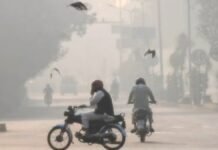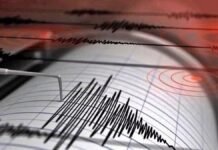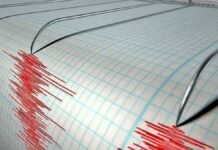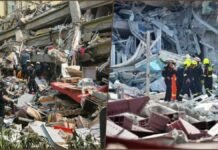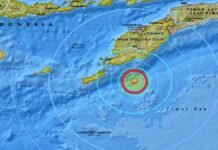
Key Points:
- Death toll from 6.9-magnitude earthquake in central Philippines has risen to 60, with 147 injured and rising
- Quake struck at 9:59 PM local time on September 30, 2025, with epicenter 17-19 km northeast of Bogo City, Cebu
- Bogo City, Medellin, and San Remigio towns most severely affected; 22 buildings collapsed including churches and fire stations
- Philippine Institute of Volcanology recorded 379 aftershocks rocking the region; no tsunami threat confirmed
- Cebu Provincial Hospital overwhelmed with injured patients; medical volunteers urgently needed
- Region still recovering from tropical storm that killed 27 people just days earlier on Friday
- US Geological Survey initially recorded quake at 7.0 magnitude before downgrading to 6.9 at 10 km depth
Philippines: A devastating 6.9-magnitude earthquake struck the central Philippines at 9:59 PM local time on Tuesday, September 30, 2025, claiming at least 60 lives and injuring more than 147 people across Cebu province. The shallow quake, centered at a depth of just 5-10 kilometers, occurred approximately 17-19 kilometers northeast of Bogo City, a coastal settlement of around 90,000 residents on the northern tip of Cebu island.
The US Geological Survey initially recorded the earthquake’s magnitude at 7.0 before revising it downward to 6.9. The tremor was triggered by movement along a local fault line and sent terrified residents scrambling into the streets in complete darkness as the intense shaking severed power lines across the region.
Bogo City Bears Brunt of Catastrophe
Bogo City emerged as the epicenter of devastation, with at least 14 confirmed deaths, though disaster-mitigation officer Rex Ygot warned that the toll was expected to rise significantly. Emergency workers struggled to transport heavy excavation equipment to a mountain village hit by landslides and falling boulders, where residents remained trapped beneath collapsed shanties.
“It’s hard to move in the area because there are hazards,” explained Glenn Ursal, a disaster-mitigation officer, noting that survivors were being transported to hospitals under extremely challenging conditions. The earthquake damaged a fire station, concrete roads, asphalt highways, and an historic Catholic church in nearby Daanbantayan town.
Multiple Towns Report Casualties and Infrastructure Collapse
The neighboring town of Medellin reported at least 12 fatalities as residents were struck by falling ceilings and collapsing walls, with many victims killed while sleeping in their homes. Gemma Villamor, who heads Medellin’s disaster-mitigation office, confirmed the grim toll as rescue teams worked through rubble.
San Remigio town witnessed particularly tragic scenes, with five people killed including three coast guard personnel, one firefighter, and a child—all of whom were attempting to flee to safety from a basketball game disrupted by the violent tremors. Vice Mayor Alfie Reynes made urgent appeals for food and water supplies, revealing that the town’s entire water system had been destroyed by the earthquake.
Hospitals Overwhelmed as Aftershocks Continue
Cebu Provincial Hospital in Bogo transformed into a scene of chaos as injured children cried and adults screamed while receiving treatment on beds laid out beneath blue tents on the hospital driveway. Medical staff evacuated patients from the building amid fears of further structural damage as hundreds of aftershocks continued to rock the region throughout Tuesday night and into Wednesday.
The Philippine Institute of Volcanology and Seismology reported that approximately 379 aftershocks had struck the area, creating additional hazards for rescue operations. Hospital workers were observed carrying black body bags on stretchers into vans destined for local mortuaries, as the Office of Civil Defence deputy administrator Rafaelito Alejandro warned that casualty numbers remained “very fluid”.
22 Buildings Damaged, Power Grid Collapses
The earthquake destroyed or severely damaged at least 22 buildings across Cebu and neighboring islands, including residential structures, commercial establishments, a gymnasium, and public buildings. A historic stone church was among the significant architectural casualties. The quake created deep cracks in asphalt and concrete roads, complicating emergency response efforts.
The entire power grid serving Cebu and several nearby islands failed completely, plunging millions of residents into darkness and hampering initial rescue operations. Firefighter Rey Cañete described the terrifying moment: “We were in our barracks to retire for the day when the ground started to shake and we rushed out but stumbled to the ground because of the intense shaking”. He and three fellow firefighters sustained cuts and bruises as a concrete wall in their fire station collapsed.
Residents Describe Moments of Terror
Hundreds of terrified residents gathered in darkness on a grassy field near Bogo’s fire station, refusing to return to their homes hours after the initial quake. In the resort town of Bantayan, locals described rocks falling with deafening bangs, saying “We were so scared we couldn’t move and were just waiting for the tremors to subside”.
Dramatic footage circulating on social media showed churches collapsing in real-time and bridges swaying violently as the ground heaved beneath them. One survivor recounted watching buildings that had stood for generations crumble within seconds.
Governor Appeals for Calm, Government Mobilizes Response
Cebu Governor Pamela Baricuatro delivered an urgent video message via Facebook Live, appealing to residents to remain calm and move to open spaces away from walls and buildings. “It could be worse than we think,” she warned, explaining that the full extent of damage would not be known until daylight revealed conditions in remote areas.
The governor confirmed she was in ongoing communication with the presidential office regarding emergency assistance. The Cebu government issued urgent calls for medical volunteers to assist overwhelmed healthcare facilities.
Tsunami Warning Issued Then Lifted
The Philippine Institute of Volcanology and Seismology initially issued a tsunami warning, advising residents of Cebu, Leyte, and Biliran provinces to evacuate coastal areas due to possible waves reaching up to 1 meter in height. Institute Director Teresito Bacolcol later lifted the warning after monitoring confirmed no unusual wave activity. The Pacific Tsunami Warning Center in Hawaii independently verified there was no tsunami risk from the earthquake.
Disaster Compounds Recent Storm Damage
The earthquake struck a region still reeling from recovery efforts following a tropical storm that battered central Philippines just five days earlier on Friday, September 27, 2025. That storm claimed at least 27 lives, primarily from drownings and falling trees, knocked out power in entire cities and towns, and forced the evacuation of tens of thousands of residents.
The compounding disasters have stretched emergency response resources to their limits and left communities facing mounting infrastructure damage.
Philippines’ Geographic Vulnerability
The Philippines ranks among the world’s most disaster-prone nations, experiencing frequent earthquakes and volcanic eruptions due to its location on the Pacific “Ring of Fire” an arc of seismic faults encircling the Pacific Ocean. The archipelago nation is additionally battered by approximately 20 typhoons and tropical storms annually, creating a perpetual cycle of natural disasters that test the resilience of its 110 million inhabitants.
The shallow depth of Tuesday’s earthquake occurring just 5-10 kilometers beneath the surface amplified its destructive power, as shallow quakes typically cause more intense ground shaking than deeper seismic events. Seismologists warn that aftershocks could continue for days or even weeks, posing ongoing risks to damaged structures and rescue personnel working in unstable environments.









